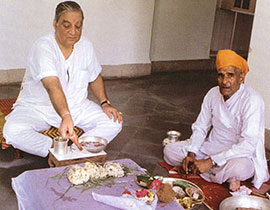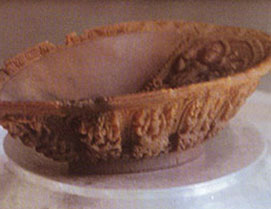FESTIVALS AND CEREMONIES
FESTIVALS AND CEREMONIES
In India, all festivals is whether big or small are connected with religion, for it pervades all aspects of life. All actions are inspired by Karma, by the intention of leading a life of good deeds, and following the sacred scriptures. The concept of rebirth strongly influences Hindu belief: human life is the last and highest of the karmic journey in its quest for salvation in which atma or the soul is to attain moksha and merge with the Paramatma, i.e. the Supreme Being or God. The soul traverses this evolution from a microbe or an insect to a large creature and so on, until it reaches the topmost human form. The final step from here is moksha or enlightenment where the human soul merges with the divine soul. On the other hand, any deviation or bad karma will lead the soul to be reborn as something inferior. And so the cycle goes, until the attainment of salvation.
Thus there is no distinction between religious or wordly events in this chapter. It is, however, divided into two sections: into recurring events, which are observed by the Kotah family every year, such as Dushera, Holi or the birthday of a living person, and in , single events, observed only once in the lifetime of a family-member, as for example birth or marriage.
DUSHERA PUJAS
Dushera, also spelled Dussehra, Dashahra or Dassera, is one of the most popular festivals in India, It is celebrated for ten days and Commences on the day of the new moon in the lunar month of Asvina (September/October). Dushera literally means tenth night. It follows Navaratri, the nine festive nights. In large parts of India this is the greatest among the many religious festivals.
The festivals, also called Durga puja, commemorates the combat of the Great Goddess, Durga, with the buffalo-demon Mahishasura and simultaneously the battle of lord Rama against Ravana, the ten-headed demon-king of Lanka. Both events culminate on the tenth day in a great victory over Mahishasura and Ravana respectively. Thus the various celebrations of the festival demonstrate the victory of virtue over evil.
As explained in Brief Note on Hinduism, Vishnu acts as helper in need and, if requested, descends from his abode in an animal or human incarnation to restore law and order on earth. But a few challenges are so great that even he is at his wits end. Here the Great Goddess, Durga, steps in.
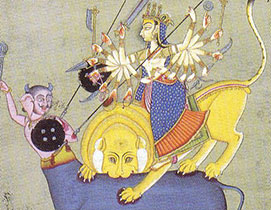
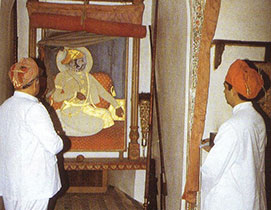
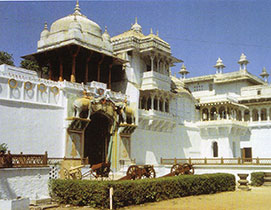
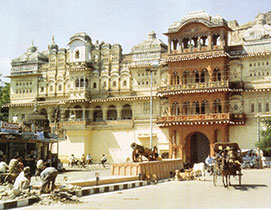
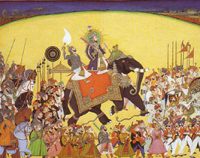
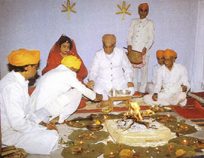
There is a legend that the buffalo-demon Mahishasura, the demon-king, was granted the boon by God Brahma that no male would be capable of killing him. Mahishasura, intoxicated with pride, commenced a war with the gods; he defeated them, and finally became the emperor of the three worlds.
After a fight of some hundred years, he even took possession of the abode of the gods, who had to flee. Helpless, Indra and the other gods ran to Brahma, who in turn took them to Vishnu and Shiva, where the gods submitted their grievances. Vishnu and Shiva were enraged, but could not act themselves, for by virtue of Brahma’s boon, Mahishasur could be killed only by a woman. So Vishnu decided to kill the buffalo-demon by sending a woman.
Subsequently all deities, including Vishnu and Shiva, created a mighty woman, emanating all their energy into her. Thus the Goddess Durga came into being as the pooled energy and power of all the gods. In addition they each supplied Durga with a powerful weapon, also with jewels and ornaments.
Thereafter Durga, Wielding weapons in her eighteen arms and riding a lion, challenged Mahishasura. Assisted by other goddesses, she defeated his army, and after a terrible battle cut off the monster’s head and killed him. That is why the Goddess is usually depicted at the moment of her triumph, having just decapitated the buffalo: Mahisha appears in his demon form from the bleeding stump of the dying animal’s neck and is speared by the Goddess. Her mount, the lion, assists her by biting into the back of the beast. Therefore Durga also has the name Mahishasuramardani, the killer of Mahishasura.
On the tenth day – in Kota on the evening of the ninth day – Durga kills the buffalo-demon. To commemorate this and to honour the Goddess, a buffalo is killed by the blow of a sword. Formely this was done by the worldly rulers, the Rajas and Maharajas. Later, they commanded the killing by others. Nowadays blood sacrifices are generally not performed, but goats and buffaloes are still sacrified in quite a few places. In Kota the buffalo is replaced by a pumpkin, which is split in two with a hunting knife.
The main feature of Dushera is, however, the Rama-lila which is based on the epic Ramayana, one of the oldest and greatest Indian epics. According to legend it was composed in Sanskrit by the sage and poet Valmiki. Most probably the epic was first recorded in Sanskrit at about 500-300 BC but it goes back much further. It is the story of Rama, the seventh incarnation of Vishnu, born as the heir-apparent to the throne of Ayodhya, the capital of a kingdom in the Ganges valley. The Ramayana is also a story of fidelity to the spouse, even under the most difficult circumstances, and a story of the victory of righteousness over evil. Its hero Rama is the upholder of truth and dharma.
This very long tale of love and adventure with its implicated great religious experience is dear to almost every Hindu’s heart, regardless of caste and age. Hardly a Hindu child is unfamiliar with the story.
In brief the Ramayana-epic runs as follows:
In bygone days there was an evil-minded, ten-headed demon by the name of Ravana, who ruled over the island of Lanka (present-day Sri Lanka). He had once practiced great austerities and therefore – as a reward – had been granted a boon by Brahma, which made him invincible, even to the deities and demons. Secure in this knowledge, Ravana began to terrorise the world. He even dared to rock Shiva’s throne. The world became grief-stricken by his evil deeds. So the Goddess of the earth, Bhumidevi, assumed the form of a cow, went to Indra and told him about Ravana’s atrocities. Indra took Bhumidevi to Brahma, who in turn accompanied them to the great commander in chief, Vishnu. Knowing of the boon granted to Ravana, Vishnu decided to incarnate himself as Rama, son and heir-apparent of the king of Ayodhya, since only a human could destroy Ravana.
Rama was the oldest of four brother and hence the crown prince. He married Sita, the daughter of another king. By the intrigues of the junior wife of his father, crown-prince Rama was exiled to the forest for fourteen years. His wife Sita and younger brother Lakshmana considered it their duty to accompany Rama into exile.
After many adventures with demons and encounters with holy men, an ogress, disguised as a beautiful girl, tried to seduce Rama, but he, as the true guardian of family morals, rejected her advances. She persisted, Lakshmana cut off her nose and both her ears. Thus disfigured, she resumed her true shape, flew away and reported the affairs to her brother. This was no other but the evil Ravana.
Ravana in turn abducted Rama’s wife Sita by trickery, and took her to his golden palace in Lanka, where she was held prisoner. As a faithful wife, she turned down all Ravana’s advances.
Rama and his brother Lakshmana, assisted by the monkey-general Hanuman and an army of monkeys and bears, found out her where abouts and attacked the golden citadel of Lanka. There, after heavy battles between Rama’s monkey and bear army and Ravana’s demon hordes. Rama defeated and killed his adversary in the final showdown and rescued Sita. His mission accomplished, Rama burned Ravana and two of his evil bothers, and crowned the third, benevolent brother new king of Lanka. As the fourteen years of exile had just expired, Rama together with Sita, Lakshmana and Hanuman, returned happily to Ayodhya, where all this while Rama’s brother Bharata, after their father’s death, had governed in the name of Rama. The latter was crowned king and he reigned for many years.
This is a very abridged rendition of the Ramayana emphasizing events which are of importance for the Dushera festival.
In olden days, the pageantry and the procession of Dushera of Kota State was famous throughout North India, as was that of Mysore State in the South. The festival in Kotah turns into a large fair held at the Dushera maidan or field. Maharao Sir Umed Singh II of Kotah was the first to organize a Dushera mela or fair in 1892. Year after year it has grown. Merchants set up shops to display and sell their wares, stalls and put up for food and special delicacies, the government and big business set up exhibitions showing various things to educate and lure farmers and citizens.
CEREMONIES
The house of Kotah limits its activities during the ten days of Dushera to pujas at select places and to the preparations of Rama’s final battle with Ravana. With few exceptions only the men attend. From the royal side it is the Maharao, his son and some members of his entourage and one or two of his nobles. Part of the pujas take place in the City Palaces, others in the four cardinal directions of Kotah at special locations. The service is performed by the purohit who acts on behalf of the Maharao and is assisted by the chhote devtaji, who usually just watches. The sevadar vyas is usually also present. He is an important Brahmin, who comments on religious texts and discussions. In locations outside the City Palace the service is executed by the same men, while the local pujari attends, as he is in an inferior position. On several days prescribed rituals have to be performed. Only on the forth and sixth day nothing particular happens.
First Day
The celebrations commence on Ashvina Shukla , the first day of the bright half of Asvina, with the sthapna, i.e. inaugural puja. The Maharao and his entourage visit the Ashapura Mandir in the City Palace to pay respects to the Kul Devi, the clan goddess of the Kotah family. Ashapura signifies fulfiller of hope,and this idol is considered to be a manifestation of Goddess Durga.
The Goddess is identified with Shakambari Devi. Her ancient temple from the 5th century AD is still located on the shores of the Sambhar lake, the big inland lake about fifty miles south of Jaipur. Later, the Devi also became known as Ashapura.
On this day, the priests plant the jowara (a kind of millet) in the temple and akhand deep, the eternal lamp, is lit which burns uninterruptedly until Dushera.
The importance of the Durga worship by all Rajputs is because they are Shaktas, i.e. followers of Shakti, the great principle of cosmic female energy which the Devi embodies. Being of the warrior class, the Rajputs worship the Goddess, for she is the militant destroyer of evil, her fierce form of divine energy avenging all wrongs. Thus she is the benefactor of the Kshatriyas. The pujas with the emphasis on sacrifice, worship of Shastra or weapons and vahan or vehicles of transport clearly exemplify the importance laid in ancient and medieval times on the preparations for the campaigning season by all kings, warriors, and armies. This is possible only after the countryside has dried after the four-month period of monsoon floods and mud.
Second, third and fourth day
On these days there are no special ceremonies. But independent of the Navaratri or Dushera puja, His Highness in 1997 drove out to a place called Charan chowki with his entourage to pay his respects to the importance of the Ballabh Kul, rested during the monsoon in 1670(VS 1727), when the deity was wandering around and seeking a safe sanctuary. In the little mandir temple, a footprint of Srinathji is worshipped.
Fifth day
On the morning of Panchmi, the fifth day of Navaratri, Asvina Shukla 5, the Maharao observes a puja at the ancient, eighth miles east of Kota. This is a pilgrim centre where a very colourful small street emerges on such festival days, leading past many shops with all sorts of merchandise that are indispensable as offerings.
Danshtra Devi has been worshipped by the Bundi princes since 1264, and later by the Kotah rulers. The temple was enlarged and subsequently improved upon during the reigns of Rao Jagat Singh, Rao Kishore Singh, Maharao Ram Singh, and finally Maharao Umed Singh II. The puja is performed for the victory in arms, for the longevity and glorious reign of the ruler, the general well-being of the royal family, and for the prosperity of the state. After all such pujas of the Devi, it was mandatory to offer a sacrifice in the shape of buffaloes and goats; they were beheaded with a single swift stroke of a talwar sword . Maharao Sir Umed Singh II abolished this blood sacrifice in 1925.
Sixth day
On this day, no public puja is performed.
Seventh day
On Saptmi, i.e. Asvina Shukla 7, the seventh day, the Maharao goes to Nanta village to offer worship to Kal bhairav. This place is situated about six miles west of Kotah, across the river Chambal. Here too, as at Dadh Devi, the villagers who are separated into groups of men and women, wait eagerly at the little shrine of Nanta ka Bhaironji for the Maharao and the beginning of the pujas. The almost man-sized idol represents kal Bhairav, one of several manifestation of Shiva.
After performing puja in Nanta at the temple of Kal Bhairav, the Maharao proceeds to the small and pretty shrine of Karni Mata near Abhera lake about a mile away. As the word mata-Mother indicates, the idol represents the goddess Durga. Here again some villagers, mostly women, await him.
Eighth Day
On the morning of Ashtmi, the eighth day of Navaratri, Asvina Shukla 8, the Maharao and his nobles go to the City Palace and again offer reverence to the Kul Devi Ashapura. The ceremonies correspond to those performed on the first day. In the afternoon the Ashtmi puja takes place. This is one of the most important pujas for most Rajputs and so for the Chauhans too.
From midday onwards, nine Brahmins sit in front of the sanctum sanctorum and recite the Chandi path or the Durga saptsahi. This lasts for three or four hours while shlokas are recited in cadence as prescribed in the shastras. Thereafter the purohit and the Acharya along with other Brahmins light the sacred fire in the nearby covered yard of the temple, chant further shlokas, and intermittently pour aahuti or libations of ghee, clarified butter, and grain into the fire. Around the fire ten large leaves, each with donations, are placed in the ten cardinal directions: N, NE, E, SE, S, SW, W, NW, upward and downward.
Ninth Day
On Navmi, the ninth day of Navaratri, Asvina Shukla 9, the afternoon starts with the Oobh Devi puja, again at the Ashapura mandir. In the course of the puja some jowara, millet plants that have grown since the first day are plucked out and tucked into the turban of the Maharao and his son, the Maharajkumar.
On this occasion, the subduing of the buffalo-demon Mahishasura by the Goddess Durga is celebrated. On behalf of the Maharao one of his nobles offers a sacrifice to the Kul Devi in the shape of a pumpkin. The person so deputed comes forward, and is blessed by the priest through the application of tilak on his forehead. The short sword with which he will perform the sacrifice is also blessed.
In olden days, a buffalo that had been specially bred for this purpose and given a fair bit of intoxication to make it wild, was let loose in the chaughan or field outside the palace. Then the Maharao in full armour on horseback along with his similarly accoutered nobles would ride out, chase the buffalo and await the opportunity to kill it with a blow of the sword. It required extra strength and special practice to perform this feat on horseback. This instance was repeatedly rendered in paintings
After the puja in the Ashapura temple, the Maharao proceeds to Rajmahal for Shastra puja, i.e. the worship of weapons, which are placed on a red cloth in along row of low boards. The royal insignia, the state flag, banners, and the royal nakkara-drums lie at the end. In front of the seated Maharao, a small bajot or plank exhibits the picture of Lord Srinathji and tiny steel weapons. Puja is offered to all these objects and the Maharao.
Tenth Day
On the morning of Dushera, the tenth and most important day of Navratri, Asvina Shukla 10, the Maharao first has darshan of Lord Brijnathji and performs an aarti ceremony at the Brijnathji Mandir in the City Palace. Thereafter the Maharao and his son proceed to the sillekhana and pay their respects to Maharao Bhim Singh I. After this, the group travels to Rangbari, a village six miles south of kotah, where the idol Balaji of Rangbari is worshipped.
The Rangbari Balaji has a hollowed past. It is associated with Rao Jagat Singh, second ruler of Kotah in the seventeenth centuary, who first built a Kund or well-pool for water which exists to this day. Later, in the eighteenth centuary, Maharao Guman Singh used to come here to offer his respects to a sadhu or holy man who was a great devotee of Lord Hanuman. This saintly person possessed miraculous powers.
In the early afternoon of this Dushera day, the Maharao performs the Shami puja or the worshipping of the khejdi-tree (prosopic spicigera). This tree grows plentifully in arid region, is most beneficial to farmers and has thick foliage. It is considered to be one of the manifestations of Shakti power. The worship of this khejdi-tree bestows good on the person performing it, provides riches, destroys evil, assures safe journeys, removes all obstacles in life, and bestows glory, fame, and victory.
The puja is performed by the purohit for the Maharao under a shami or khejdi-tree in the courtyard behind the main Naya Darwaza Gate entrances to the City Palace. As pointed out earlier, at this Dushera puja the Maharao, acting on behalf of the God Rama, pays obeisance to the Goddess Durga for achieving victory over the demon-king Ravana.
The group proceeds inside the City Palace for another consecration of weapons, the Revant puja which is essentially a blessing of all the arms and armour needed in war. Royal insignia and weapons are laid out and blessed by the purohit on behalf of the Maharao.
After this ceremony, the nishans, i.e. state flags and ensigns, a sword, a shield, a bow and an arrow are brought before Lord Brijnathji’s idol, where the priest blesses them in the Nishan puja by sprinkling holy water and red sindoor on them and by tying special kesaria patta or saffron-coloured ribbons.
Upon the Maharao’s arrival at the saluting base, the cannon fired the 21-gun salute from the ramparts of the fort while the bands played the anthem and the troops presented arms.
In 1992 Maharao Brijraj Singh began a new tradition: the old nobility , dignitaries, local politicians- including the Mayor of Kota, who in 1997 was a lady and government officers and ministers belonging to the Kota area invited to take part in the procession of Shri Lakshminarayanji. A reception is held on the Bada Chabutra or large raised patio in front of the palace near the Elephant gate.
Large paper and bamboo effigies of Ravana and his two brothers were erected on these grounds during the day. But before the culmination of the festivity, a puja at the base of the platform is performed by worshipping pots of sprouted jowara-millet. Thereafter, a pumpkin is placed tween Ravana’s legs, the target at which the Maharaj of Kotda- on behalf of his cousin, the Maharao, and after receiving the command from Lakshminarayanji from the elephants’s howdah.
Subsequently, the procession with the elephant returns to the City Palace, where Lakshminarayanji is reinstalled in his mandir. The festivities continue on the Rama-lila grounds well into the night.
DIVALI PUJAS
Divali – in Sanskrit deepmalika or dipawali-literally a "a garland of lights", is a Hindu Fetival of joy and lights observed in honour of the Goddess Lakshmi, But also in honour of Lord Rama. It is celebrated with great delight all over India by practically everybody – be one a Hindu or not – on the day of the new Moon in the month of Kartika. Divali also marks the last day the last day of the Hindu lunar calendar. Businessman open their new account-books, and as Winter approaches in Ayodhya when Lord Rama returned together with his Consort Sita from the battle against Ravana.
On the occasion of Divali, a Hindu’s home is cleaned and whitewashed.In the evening, the Goddess Lakshmi is worshipped along with Ganesh.Houses, roofs, gates, gardens, streets, markets, etc. are illuminated with Electric-bulbs, candels, or oil filled little earthern lamps. An open lamp Of clay filled with ghee, clarified butter, is left burning throughout the night at the place of worship of Lakshmi in order to welcome her. In front of many houses fireworks are launched to ward off evil spirits from the place.
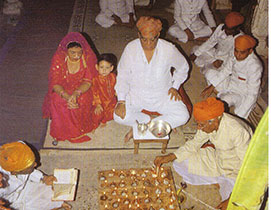
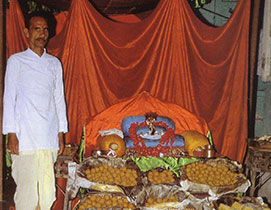
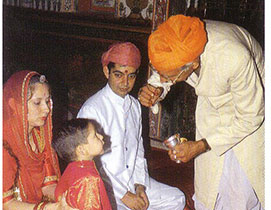
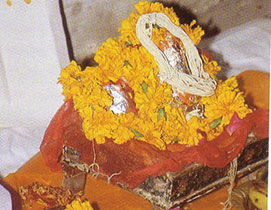
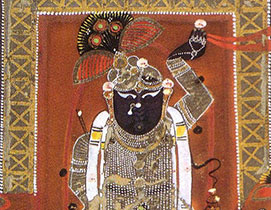
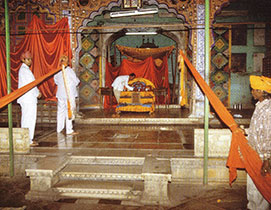
People send sweets to relatives, friends, and neighbours and, as Lakshmi Is the goddess of wealth, many, including women, indulge in gambling during the night. Young boys and girls mingle through most of the night and big garba dnaving takes place.This was all charmingly described in the 16th century poem Kavipriya by the poet Keshavdas:
"Woods and gardens, rivers and lakes,
The earth itself and heavens above
All are clear and shining bright, as if illuminated by a million lamps.
The days and nights are full of joy, and couples are gambling
The walls and courtyards in every home are gay with paintings of the gods.
The universe is pervaded with celestial light,
All men and woman are gay with love.
This is the month for earning merit by alms-giving,
Worship of God and sacred bath.
Therefore, I implore you, my love, go not from home in Kartika."
CEREMONIES
The Divali Pujas commence in the dark period of the 13th day of the month of Kartika (kartik Krishna 13), two days before the new moon, and last for five Days. This period is called panchak and ends on Kartik Shukla 2, i.e. the Second day of the bright half of Kartika that is one day after the new moon day.
In contrast to the Dushera pujas, which are celebrated mainly by the men,The ladies of the Kotah family and the young grandson also take part at the Divali pujas. Although the festival lasts altogether five days, and there are Pujas for the family every day, the royal family itself attends only two pujas.With the exception of the Dawaat Puja or "Ledger and Pen" puja, all the pujas take place in the Anand Mahal in the City Palace, a room fully decorated with wall paintings and décor dating from the mid- 19th century. One part of this mahal, hall, serves as a shrine of the Goddess Mahalakshmi, the Great Goddess Lakshmi. Two miniature paintings on a stone throne depict at the left Srinathji, representing Vishnu in his incarnation as Lord Krishna, at the right The Goddess Lakshmi, the consort of Vishnu. In between these two paintingsis a silver statue of the Goddess Mahalakshmi, behind which a Bhagavata Gita manuscript representing Saraswati is sometimes placed. All rest on a red velvet cushion on the throne.
In front of idols an Earthern pot with with water is laid out, which represents the God Rudra or Shiva. This is called Rudra Kalasham and it is manadatory in all Pujas. Next is the Navagraha, the "nine heavenly bodies" or planets affecting one’s Life represented by a grid pattern of rice with sopari in each square. They are Surya,Chandra, Bhom, Budha, Guru, Shukra, Shani, Rahu and Ketu.
The shodas matrika, the sixteen mother goddesses, or swaroops, the Manifestations of the Goddess Durga, are made of rice, again with sopari in each square. They are Gauri, Padma, Sachi, Megha, Savitri, Vijaya, Jaya, Dev Sena, Sadhwa, Swaha, Matri, Lok Matri, Dhatri, Pushti, Tushti and Atma Kul Devi. Next come the vasudhara in the form of red dots, applied in pyramidal form in Vermillion on a wooden plank, kept upright near the throne. They represents the Seven manifestations of the Goddess Durga. These are now Sri Lakshmi, Dhatri, Megha, Swaha, Pragya and Saraswati. Below this is a Kalamdaan, a penholder with pens. Below that is drawn a Talwar or sword, representing the Goddess Kali, and ten silver coins with one gold coin in the middle representing Lakshmi. Thus all three Great Goddesses, Mahakali, Mahalakshmi and Mahasaraswati, are represented. And lastly below three betelnuts represent Indra, Kubera and Ganesh.
All pujas start with an invocation to God Ganesh.
First day of Puja
On the first day, a special akhand deep or everlasting lamp with ghee is lit, Which burns uninterruptedly as long as the pujas last. The celebrations start two days before the new moon, with the first day’s puja, Dhanteras puja, taking place in the evening of Kartka Krishna 13. This puja starts with Yama Deepdaan, a puja of lamps lit to propitiate Yamaraja, the God of Death.
First, Ganesh Pujas are performed to seek the god’s blessing. Ganesh or Ganapati is invoked in the shape of a betel-nut. A special four- wick deep made Of atta or wheat flour is lit in honour of Yamaraja, the God of Death. After Dropping a coin as dakshina or gift into it, it is taken outside together with the Board on which it stands. This is performed to propitiate the God of Death as it Deflect any ill fortune or untimely death in the family.
Once this Yama Deep is brought outside, the puja items are washed, the Water in the puja vessel is refreshed and a new board is prepared for Lakshmi puja.Puja is first offered to Ganapati and then to all the gods and goddesses.This puja on Dhanteras performed by her Highness. On this occasion the husband And wife are joined together symbolically with a special symbolically with a special Cord called gath joda or granti bandhan.
Second day of Puja
The next day, in the evening of Kartik Krishna 14, the Roop Chaturdashi puja Is observed by the purohit on behalf of the family in its absence. It is a Deep-Dan puja Followed by a Mahalakshmi puja in exactly the same manner as on the previous evening.
Third day of Puja
The next day is Kartik Krishna 15 Amavashya, the last day of the dark fort-Night. Like almost everybody else in town, the royal family decorates its home and garden with many earthern oil lamps, electric bulbs; the main entrances of Brijraj Bhawan Palace are ornamented with rangoli-floor decorations in white and earthern colours.
In the evening the family, elaborately dressed ,goes to the Lakshmi shrine in the City Palace’s Anand Mahal for a festive celebration of the Amavashya puja.Twenty earthern lamps, deeps, are kept on the board, with a betel-nut representing Ganapati/Ganesh. After worshipping him, puja is performed to the twenty deeps that represent the pitr, the deceased of the family and Yamaraj. Coins are dropped into each deep as dakshina-gift; then they are taken outside. After washing the puja utensils and changing the water in the puja vessel, puja is Offered to a new set of forty deeps. After the pujas, sixteen deeps are taken out: Some are sent to the temples inside the City Palace, the rest is once more removed and kept outside on a platform.
All over the city, women in their finery place deeps in front of their houses, on road crossings, near the river or lake, in cow-sheds and in funeral grounds.With the sound of fireworks going off all over kota city, the royal family.Also ends the evening with some fireworks in front of Brijraj Bhawan.
Fourth day of Puja
This is Kartik Shukla 1, the new moon day. In the absence of the royal family the Purohit performs puja once again in the same manner as earlier. Special offerings with Sweet dishes called ayup are made to Bali, and this puja is sometimes also Called Ayup Puja.
The new moon of Divali falls on the most renowned festival of Ballabh Kul: Annakut, that is the sumptuous offering of mounds of rice together with Delicious dishes and sweets to Krishna in his incarnation as Lord Srinathji.The mountain of food is supposed to represent Mount Govardhan. This festival Commemorates Krishna’s lifting of Mount Goverdhan on his little finger of the left hand which was to protect the villagers of Braj, near Mathura, from the torrential rains sent by the angry God Indra. Indra was in a bad temper because the villagers, advised by Krishna, had stopped their sacrifices to him. Eventually Indra recognized his folly and submitted to Krishna.
As the royal house of Kotah adheres to the Ballabh Kul, Annakut is observed, Krishna as Srinathji represented here in Kota by the idol of Brijnathji.
The ceremonies take place on the fourth day in the absence of Members of the family and the purohit. The pujas are observed under the aegis of the pujaris of the Brijnathji Mandir and the general public is invited to attend.
It starts with the Goverdhan puja on a little platform behind the main Entrance of the Hathia Pol, the Elephant Gate. The idol of Lord Brijnathi is brought out from his mandir, screened off from public gaze, and placed on the platform in front of a huge wall-painting that depicts the story of Mount Goverdhan and thus substituting the mountain of food. In front the platform, on the ground, stands a little human figure made of cow-dung, ornate with peacock feathers. This represents Mount Govardhanin human form.
After the idol is put in place, the public is admitted, and the pujari Adorns the idol and makes offerings. After some time the public is excluded again, the idol is replaced on its throne in his mandir, where a huge amount of rice and food have been laid in front of him. Now during the Annakut puja the public has the possibility to worship the Lord in the shrine.
Fifth day of Puja
On this day, Kartika Shukla 2, the second day of the growing moon, the Purohit on behalf of the family performs the usual Lakshmi Puja. It is called the Doj puja, Dvitya, or Yama Dvitya. This closes the sequence of pujas during the last five days that are called panchak. Later on this day Dawaat puja, i.e. the "Ledger, Pen and Inkpot" puja is performed. As pointed out earlier, Divali also marks the beginning of the new business year, when businessman Open their new account-books. Exactly this is celebrated by this puja, which Takes place at the kacheri, the administration office of the City Palace.Nowadays the Executive officer of the Rao Madho Singh does this puja. Assisted by the purohit, he first worships "Ganesh then he draws sign of Swastika. the following is for instance written below Swastika:-
Sri Ganeshaya Namah
Sri Sri Laksminarayan Ji
Sri Sri Goverdhan Nath Ji
Sri Sri Kul Devi Ji
Kartik Shukla 2 Sanvat 2055(A.D. 1998).
"Sri Lakshmi Ji Ki Puja Ki so Lakshmi Ji Maharaj Kuber Ke sahit aur Ganesh Ji Maharaj Ridhi Sidhi sahit sada virajman rahe. Shubham.
During the Divali pujas, auspicious green garlands made with the leaf of the Asapapala tree festoon the main drops and gates of the City Palace and in the shrine of Lakshmi in Anand Mahal. The altar of Lakshmi is decorated with auspicious banana leaves. Oil lamps are lit in the evenings at these places, outside and inside in the courtyard of Rajmahal.Nowadays electric lights from the main part of the illumination of the City Palace.
Holi Festival
Holi is one of the four most important Hindu festivals and certainly the most colourful. It is celebrated or – as Indians say – "played" as a spring festival in all parts of India at the full moon of the lunar month of Phalguna and enjoyed by all without distinction of caste, creed, or sex.
Several legends are associated with Holi. They all have one common: the burning of a god or an ogress. One legend surrounds Kama, the God of Love: Once Shiva was meditating and the goddess Parvati, who was deeply in love with him, wanted to marry him. But Shiva took no notice of her. Kama disturbed Shiva’s immediately reduced the archer-god to ashes by opening his Third Eye. Kama was later restored to life by the intercession of Parvati.




The festival of Holi falls during the spring season and represents a sort of verbal rejoicing when the Indian countryside is at its best, with crops ripening in the fields, gardens blooming with flowers, and a feeling of plenty pervading the air. As written above, the festival is connected with several legends. But it also serves another social purpose - for at this time the caste divide is forgotten. In fact the shastras, the holy scriptures, enjoin all human beings at this time to forget feelings of high and low and mix and intermingle to play Holi in a spirit of love, goodwill, and with gay abandon. In olden days, abir and gulal were used during the Holi festival – coloured powder made with fine flour or other organic compounds. Water was mixed with these pigments and then thrown onto individuals or rubbed onto their faces - which brings everyone into close contact.
The Holi festival has also been a subject of art in sculpture, miniature panting. In Baramasa paintings that depict the month of Phalguna, the 16th century poet Keshavadas is quoted as follows:
"All restraint gone, the rich and the poor mix together and make merry.
Speech is free and there is no sense of shame.
Young men and women in every home in every home play Holi, smearing each other with gulal (pink powder), and fragrance of scented powders fills the air.
Why leave me alone, my love, in Phalguna, the month of merry-making?"
While the Kotah family members today play Holi only amongst themselves, the Maharao used to also participate in public celebrations, as can be seen from photographs, miniatures, or wall paintings. At the special Holi Durbar held in the Raj Mahal at the City Palace, the Maharao threw small bombs made of paper-thin cases of lac containing gulal at the nobles and courtiers which burst on impact, releasing a cloud of colour. The nobles also reciprocated and the whole place was a riotous colourful scene. Special dancing girls stood outside in the open courtyard singing the well-known bawdy songs with full expletives, set to good music.
Maharao Ram Singh was a famous and ubiquitous Holi player in the 19th century. He was a ruler with a zest for life, and he was most innovative. As many contemporary miniatures faithfully record, he for example rode on a horse on top of the roof of the Kotah palace, or had a dancing girl perform on a little placed between the tusks of his elephant when he went out in procession.
There is a line drawing on a polished plaster wall of a room in the heir-apparent palace, part of the City Palace, showing Ram Singh riding his elephant in the streets of Kotah and spraying coloured water on his subjects with a hose-pipe. The pressure for the water was provided by the palace fire-engine, pumped by servants with mechanical bellows-pumps. There are several miniatures and wall paintings of the same event. "Playing Holi was one of the unique and delightful ways by which the ruler mixed and rubbed shoulders with his people," who in turn threw colour on their ruler. This public celebration of Holi was maintained by Maharao Umed Singh II up to 1925 where His Highness starts the Hathi Ki holi, i.e. playing Holi from an elephant.
Nowadays playing Holi is an affair of the young members of the Kotah family. The young Bhanwar for instance enjoys playing with playmates. But the Maharao may become involved on one of his frequent trips.
CHAITRA NAVARATRI
In the course of the year, there are four navaratris or nine nights, but the most celebrated ones are firstly the one which falls in the month of Chaitra (March/April) and secondly the one which falls in Asvina (September/October), before the Dushera festival.
The Chaitra Navaratri is closely connected with the birth of Rama: he was born Navmi, the ninth day of the bright fortnight of Chaitra, hence it is called. Ram navmi. Throughout the nine days, the Durga saptsati is recited and the usual pujas are offered to the Goddess. The first day of Navaratri also marks the beginning of the New Year of the prevalent Hindu calendar called Vikram Samvat(V.S.)
RAKSHABANDHAN CEREMONY
Rakshabandhan is a simple ceremony of tying a sacred thread-bracelet around a protector’s wrist, a ritual which dates back to ancient Vedic times (raksha signifies protection, bandhan signifies means bond or tie). In those days, rishis or sages and learned Brahmins who lived unarmed in forests, at a certain auspicious period tied the rakshasutra or protective thread-bracelet around the right wrist of a king, satrap or powerful person, signaling that they sought his protection, in return for which they blessed him with peace, prosperity, and long life. This would be at the time of Shravan Purnima, the full moon day of Sharavan, one of the four months of monsoon period. The four-month period of the rains was a time for deep meditation and pursuit of knowledge as one was rooted at one place in an ashram by the very nature of the weather. Even today the Brahmins tie the rakshabandhan to a Rajput- as he is the protector and defender of the faith.
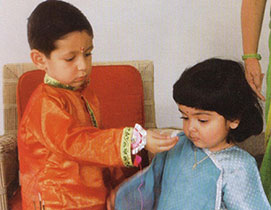
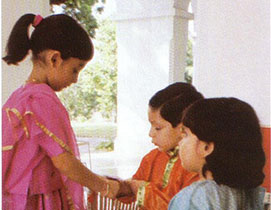
Several legends are associated with Holi. They all have one common: the burning of a god or an ogress. One legend surrounds Kama, the God of Love: Once Shiva was meditating and the goddess Parvati, who was deeply in love with him, wanted to marry him. But Shiva took no notice of her. Kama disturbed Shiva’s immediately reduced the archer-god to ashes by opening his Third Eye. Kama was later restored to life by the intercession of Parvati.
SHRADDH CEREMONY
The Hindus hold great respect for their ancestors or pitr; shraddh is a ceremony that honours the dead. Besides the gods, the pitr are venerated as well.
The fortnight honouring the dead is called Shraddh paksh which immediately precedes the bright period of Asvina Navratri. The puja for shraddh can be offered anywhere, but it is usually in the private home. It is only performed by the head of the family or in his absence the priest. Shraddh is a very private ceremony and no one else attends.
